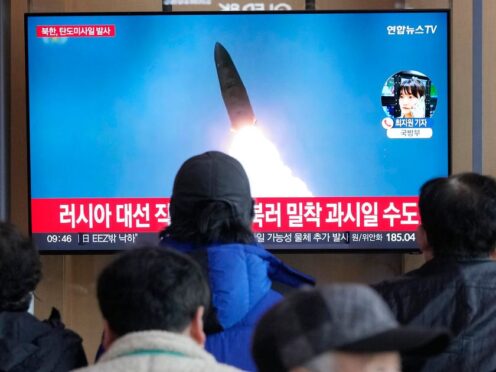North Korea fired multiple short-range ballistic missiles towards its eastern waters on Monday morning, its neighbours said.
It comes days after the end of the South Korean-US military drills that the North views as an invasion rehearsal.
The launches — North Korea’s first known missile testing activities in about a month — came as US Secretary of State Antony Blinken was in Seoul for a conference.
Outside experts earlier predicted North Korea would extend its run of missile tests and intensify its warlike rhetoric ahead of the US presidential election in November to boost its leverage in future diplomacy.
d flight distance of
Japan’s Defence Ministry said North Korea fired three missiles, two together at 7.44am and the other about 37 minutes later.
Japanese Prime Minister Fumio Kishida told a parliamentary session that the North Korean missiles landed in the waters between the Korean Peninsula and Japan, all outside of Japan’s exclusive economic zone, and that no damage or injuries have been reported.
Mr Kishida denounced North Korea’s repeated ballistic missile tests as acts “that threaten the peace and safety of Japan, the region and the international society”.
He said Japan strongly protested against North Korea over its testing activities, saying they violated UN Security Council resolutions that ban the North from engaging in any ballistic activities.
South Korea’s military said it also detected “several” suspected short-range ballistic launches by North Korea on Monday morning.
The Joint Chiefs of Staff called the launches “clear provocation” that threaten peace on the Korean Peninsula.
It said South Korea will maintain readiness to repel any provocation by North Korea, based on its solid military alliance with the United States.
According to Japanese and South Korean assessments, the North Korean missiles fired from its capital region travelled a distance of 300-350 kilometres (about 185-220 miles) and reached a maximum altitude of 50 kilometres (about 30 miles).
Observers say the missiles’ flight distances indicate they are weapons targeting major facilities in South Korea, such as its military headquarters in the central region.
The US State Department condemned the launches, saying they pose a threat to the North’s neighbours and undermine regional security. A State Department statement said the US’ commitment to the defence of South Korea and Japan remains “ironclad”.
The US stations a total of 80,000 troops in South Korea and Japan, the backbone of its military presence in the Asia-Pacific region.
During the South Korea-US military drills that ended on Thursday, North Korean leader Kim Jong Un guided a series of military training exercises involving tanks, artillery guns and paratroopers and called for greater war fighting capabilities.
The 11-day South Korean-US drills involved a computer-simulated command post training and 48 kinds of field exercises, twice the number conducted last year.
The North did not perform any missile tests during its rivals’ training, however.
Its missile tests are considered much bigger provocations as North Korea has been pushing hard to mount nuclear warheads on its missiles targeting the US mainland and its allies.
Many experts say North Korea already has nuclear-armed missiles capable of reaching all of South Korea and Japan, but it has yet to have functioning long-range missiles that can strike the US mainland.
Before Monday’s launches, North Korea last carried out missile tests in mid-February by firing cruise missiles into the sea.
